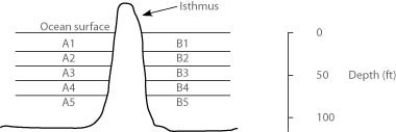Multiple Choice
Use the following description to answer the question.
In the oceans on either side of the Isthmus of Panama are 30 species of snapping shrimp; some are shallow-water species, others are adapted to deep water. There are 15 species on the Pacific side and 15 different species on the Atlantic side. The Isthmus of Panama started rising about 10 million years ago. The oceans were completely separated by the isthmus about 3 million years ago.
In the figure, the isthmus separates the Pacific Ocean on the left (side A) from the Atlantic Ocean on the right (side B) . The seawater on either side of the isthmus is separated into five depth habitats (1-5) , with 1 being the shallowest.
Which habitats should harbor snapping shrimp species with the greatest degree of genetic divergence from each other?
A) A1 and A5
B) A1 and B5
C) A5 and B5
D) Both A1/A5 and B1/B5 should have the greatest, but equal amounts of, genetic divergence
Correct Answer:

Verified
Correct Answer:
Verified
Q32: The largest unit within which gene flow
Q57: Use the following information to answer the
Q59: Use the following description to answer the
Q60: In a hypothetical situation, a certain species
Q61: You are confronted with a box of
Q63: Use the following information to answer the
Q64: Which of these animals could overcome the
Q65: Two researchers experimentally formed tetraploid frogs by
Q66: The phenomenon of fusion is likely to
Q67: Most causes of speciation are relatively slow